Culinary fads in Ancient Rome: foods that shocked or inspired modern palates reveal much more than just recipes; they offer a window into the society and cultural values of one of history’s greatest empires. Ancient Roman cuisine was a complex tapestry reflecting social hierarchy, economic conditions, and regional diversity.
Two distinct food worlds coexisted:
- Everyday fare: Simple dishes like porridge, legumes, and vegetables sustained the common people.
- Luxury cuisine: Exotic ingredients and elaborate preparations showcased wealth and status among the elite.
This dual nature of Roman food carried strong social implications. Dining was not only about nourishment but also about displaying power, identity, and refinement. Exploring these culinary trends allows you to understand how food functioned as both sustenance and spectacle in ancient Rome’s vibrant cultural landscape.
The Culinary Landscape of Ancient Rome
The culinary heritage of the Roman Empire is best understood through key historical texts, with De Re Coquinaria by Apicius standing out as a cornerstone. This ancient cookbook, attributed to a renowned gourmand, compiles around 500 recipes that reveal not only the flavors but also the culinary techniques prevalent from the 1st to 5th centuries AD.
Roman ingredients were remarkably diverse, reflecting the vast expanse of the empire. Spices and exotic foods traveled from distant provinces, introducing unique tastes and aromas to Roman tables. Among these were imported pepper, silphium (a now-extinct herb), dried fruits, nuts like chestnuts, and seafood from the Mediterranean coasts. Local staples such as grains, olives, and legumes formed the backbone of everyday meals but often blended with these luxurious imports for elite banquets.
Food presentation held immense significance in Roman dining culture. Banquets were not just about sustenance but about spectacle and status. Hosts showcased their wealth by arranging dishes with theatrical flair:
- Elaborate platters featuring vibrant colors and intricate garnishes
- The use of edible gold leaf or dazzling spices to impress guests
- Strategic placement of rare or surprising ingredients to create conversation pieces
The visual appeal complemented taste and aroma, creating a multisensory experience that elevated dining into an art form. This approach reinforced social hierarchies—where what you ate and how it appeared communicated your place in society.
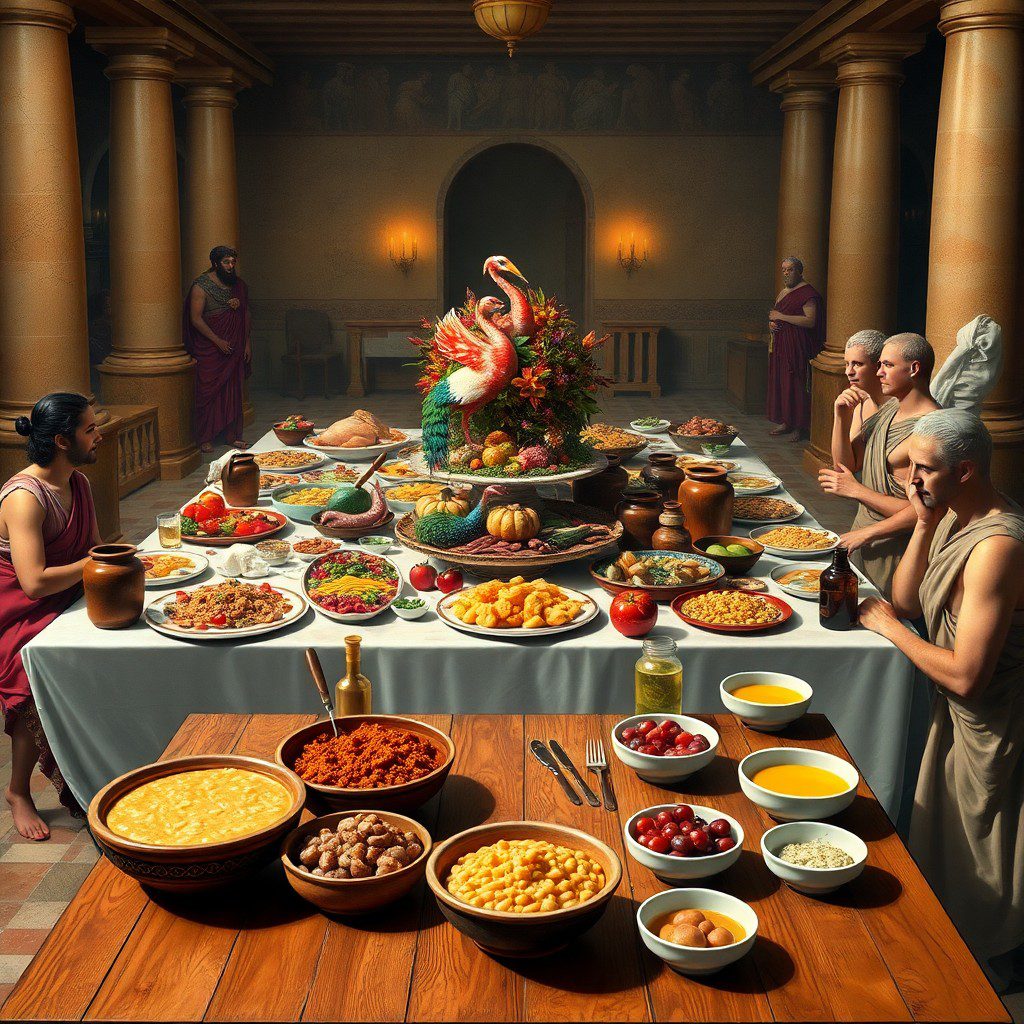
Everyday Foods vs. Extravagant Dishes
Roman cuisine displayed a striking contrast between daily sustenance and lavish banquets.
Food for the Common People
For most Romans, puls—a simple porridge made from farro or barley—served as a staple food. This humble dish often combined with legumes such as lentils, chickpeas, and broad beans, which provided essential protein. Vegetables like cabbage, leeks, and onions were common additions alongside locally caught fish, forming balanced, nourishing meals for the majority.
Food for the Elite
Elite tables presented an entirely different experience. Exotic ingredients and luxury foods dominated these feasts, designed to impress and assert status. Consider the flamboyant dishes recorded in De Re Coquinaria: flamingo braised in vinegar offered a rare and expensive centerpiece, while peacock served in a peppery wine sauce dazzled guests not only with flavor but with the spectacle of presentation. These dishes required access to distant provinces of the Roman Empire where such birds were procured or bred under controlled conditions.
The Role of Spices and Condiments
Spices and condiments bridged everyday and elite cuisine but varied significantly in quantity and variety. The fermented fish sauce garum was ubiquitous across social classes; it enhanced flavors in common stews as much as in intricate delicacies. Luxury diners might complement their menus with imported spices such as pepper, cumin, and silphium—a now-extinct plant highly prized for its unique taste.
This duality of Roman food culture demonstrates how culinary practices mirrored societal divisions: sustenance for the many contrasted sharply with opulence for the few, yet both realms shared foundational ingredients like legumes and garum that defined Roman flavor profiles.
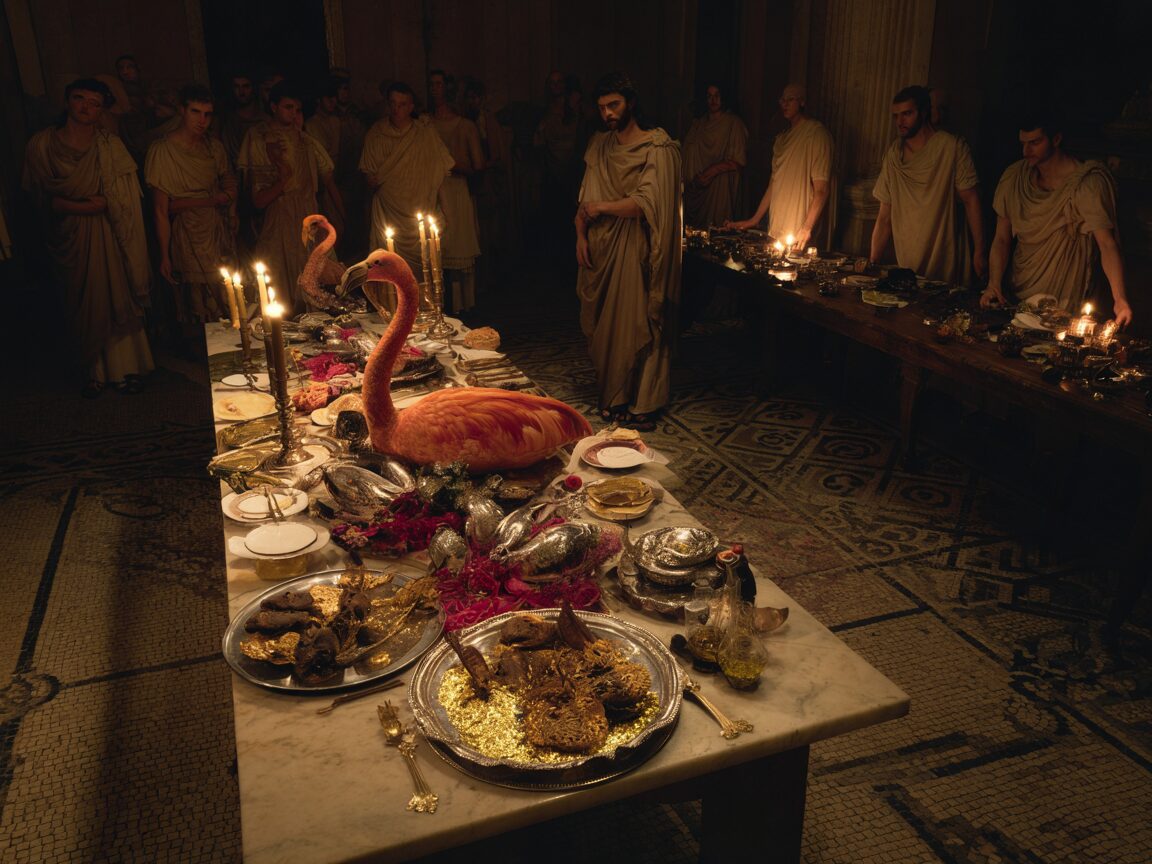
Shocking Delicacies That Surprised Modern Palates
Ancient Roman dining included several unusual foods that can startle or fascinate contemporary eaters. These culinary fads reveal much about Roman tastes and social customs.
Dormice Stuffed with Minced Pork
Dormice stuffed with minced pork stood out as a delicacy prized by the elite. Romans would fatten dormice in special terracotta containers called gliraria before cooking them. The preparation involved seasoning the dormouse with herbs, nuts, and minced pork, then roasting or baking it. This dish symbolized luxury and was often served at banquets to impress guests. Eating dormice today might seem strange or even off-putting, but in Rome, it reflected refinement and culinary sophistication.
Braised Flamingo
Braised flamingo represented one of the most extravagant dishes recorded in De Re Coquinaria. The recipe called for flamingo meat to be cooked slowly in vinegar, wine, and spices such as lovage and pepper. Flamingo’s vibrant pink plumage and exotic status made it a showpiece at feasts. Modern palates may recoil at the idea of consuming flamingo due to cultural associations and ethical considerations. Its strong gamey flavor combined with pungent vinegar contrasts sharply with common contemporary tastes.
Widespread Use of Garum
The widespread use of garum, a fermented fish sauce, is another element that shocks many modern food enthusiasts. Garum was poured liberally over meats, vegetables, eggs, and surprisingly, even sweets. Its intense umami flavor functioned as a seasoning backbone in Roman kitchens but could overwhelm those unfamiliar with fermented condiments. Some ancient recipes paired garum with honey or fruit sauces, creating unusual flavor combinations that challenge present-day dessert norms.
These unusual Roman foods underscore how taste preferences evolve while highlighting the empire’s penchant for gastronomic spectacle and innovation.
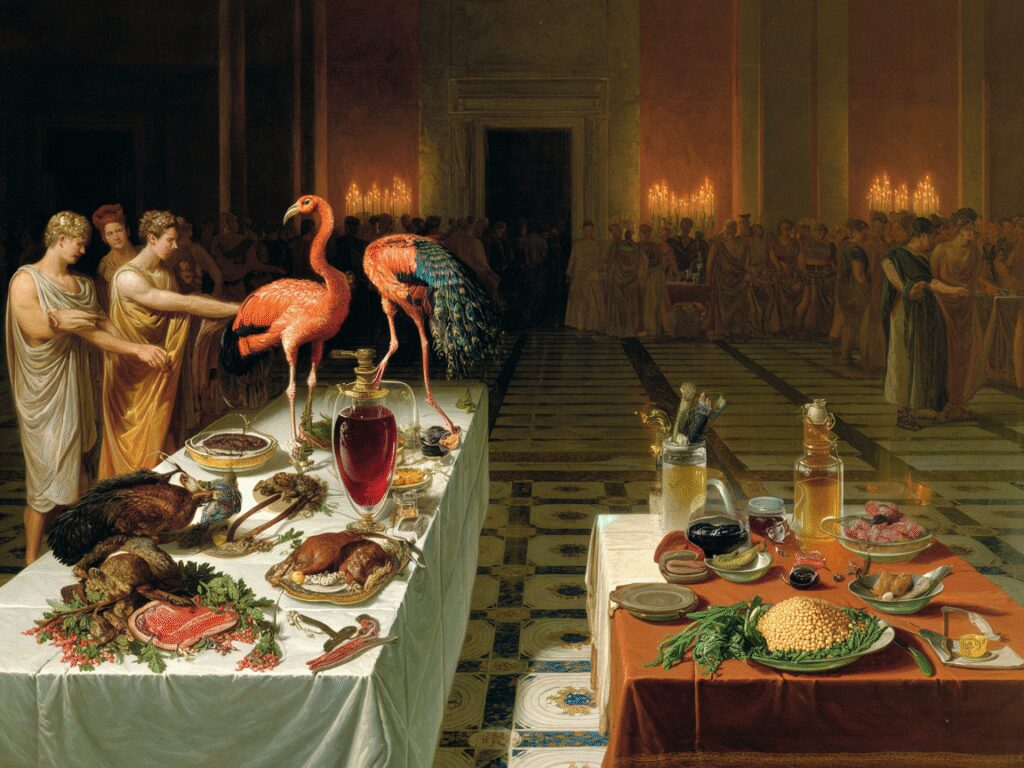
Garum: The Ubiquitous Condiment of Ancient Rome
Garum was the essential condiment in ancient Roman kitchens, created through a process known as garum fermentation. This sauce was produced by layering small fish—such as anchovies or mackerel—with salt and allowing them to ferment under the sun for several months. The resulting liquid was then strained, yielding a pungent, flavorful fish sauce prized across the empire.
Characteristics of garum production:
- Utilized various fish parts including intestines and blood.
- Fermentation created intense umami flavors.
- Concentrated and salty, often diluted before use.
The versatility of garum extended far beyond meats or fish dishes. Romans applied it generously on:
- Eggs and vegetables, adding depth to otherwise simple fare.
- Meats, from common pork cuts to luxurious game.
- Even sweets and desserts, where it provided a surprising salty contrast to honey or fruit preparations.
The extensive condiment usage of garum reflected its cultural importance as both flavor enhancer and status symbol. It was available in different qualities; the finest “liquamen” fetched high prices among elites.
Modern palates often find garum’s taste challenging due to its strong fermented aroma and salty intensity. Some describe it as overpowering or off-putting, especially when applied liberally. Yet, aficionados recognize its complexity and consider it a precursor to contemporary umami-rich sauces like Southeast Asian fish sauce or Japanese soy-based condiments.
Garum exemplifies how ancient sauces shaped flavor profiles in Roman cuisine—bold, experimental, and sometimes shocking by today’s standards—but undeniably foundational in crafting distinctive tastes across vast culinary landscapes.
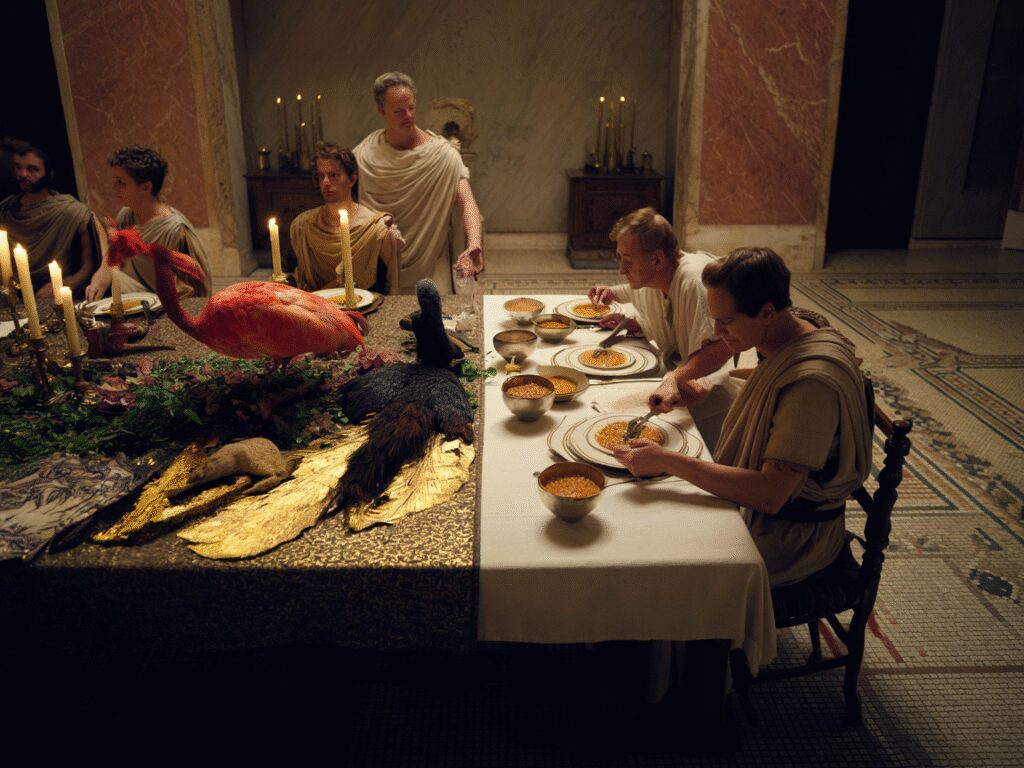
Social and Cultural Significance of Food in Ancient Rome
Roman banquets were more than just meals—they served as powerful demonstrations of wealth and social status. Hosting an elaborate feast allowed the elite to showcase their economic power and cultural sophistication. These events often featured exotic ingredients, intricate dishes, and impressive presentation techniques designed to awe guests and reinforce social hierarchies.
The Role of Sumptuary Laws
Sumptuary laws were introduced by the Roman state to limit excessive displays of luxury at these banquets. These regulations sought to restrict the types of food, quantity, and expense allowed during public feasts. The aim was to curb extravagance that might upset social order or lead to moral decay. Despite this, many aristocrats found ways to circumvent or ignore these laws, continually pushing culinary boundaries to assert dominance.
Food as a Symbol of Identity
Food functioned as a vivid symbol of cultural identity and social distinction beyond mere nourishment. Certain dishes or ingredients were associated with particular classes or regions within the empire, signaling one’s background or allegiance. For example:
- Exotic meats like peacock or dormice indicated elite status.
- Simple staples such as porridge and legumes reflected common household fare.
- The lavish use of spices and condiments like garum highlighted luxury but also connected diners to the broader Mediterranean world.
Banquets became stages where cultural values were enacted through food choices, reinforcing concepts of prestige and belonging. This symbolic role of cuisine helped shape not only personal identity but also collective Roman ideals around power, refinement, and hospitality.
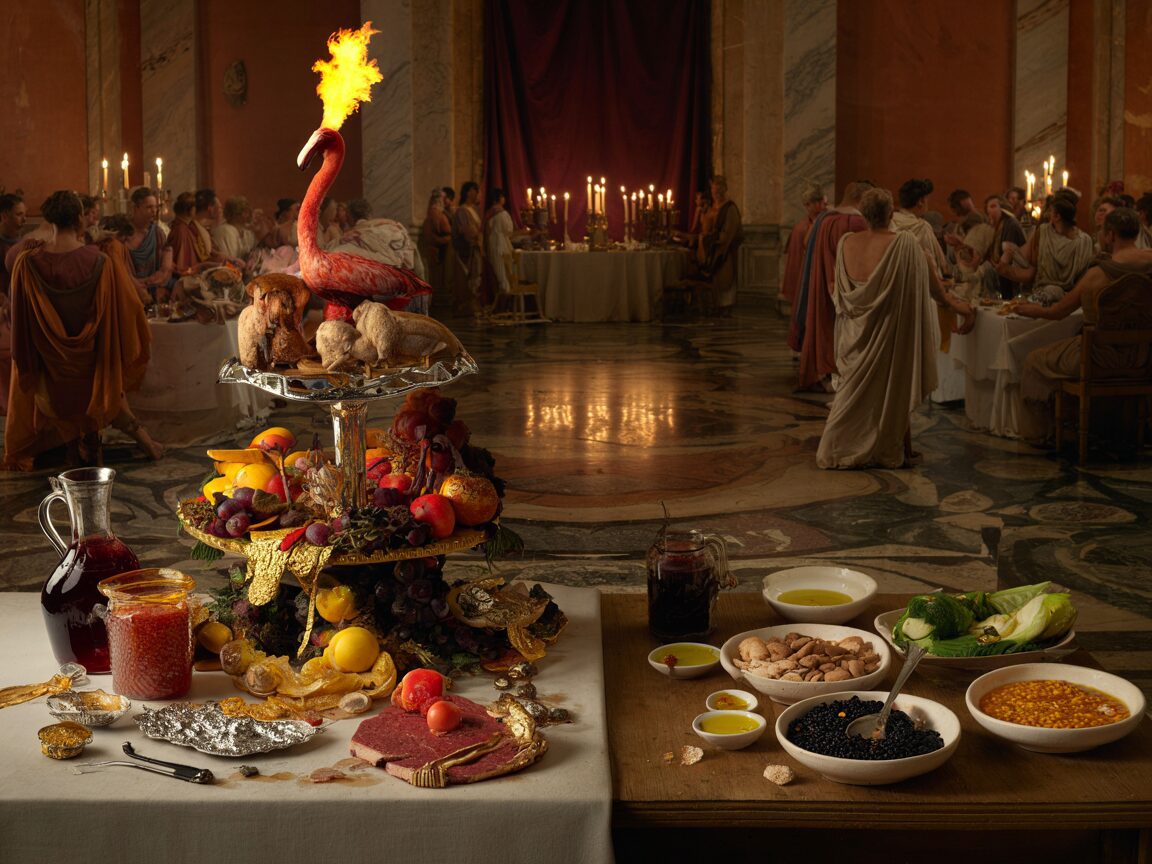
Influence on Modern Mediterranean Cuisine and Contemporary Perceptions
Ancient Roman culinary practices laid the groundwork for Mediterranean cooking traditions we see today. Many ingredients and techniques have survived over the centuries, showing a strong culinary legacy that still influences modern diets.
1. Parallels in Ingredients and Flavors
Staples like olive oil, wine, fresh herbs, legumes, and seafood remain central to both ancient and modern Mediterranean cuisine. The emphasis on seasonal produce and simple preparations mirrors Roman approaches to everyday meals. Garum’s role as a flavor enhancer has its counterpart in contemporary use of fish sauces or anchovy pastes across Mediterranean kitchens.
2. Ancient Fads Versus Contemporary Tastes
Some ancient delicacies such as stuffed dormice or flamingo dishes starkly contrast with modern sensibilities but highlight the Romans’ adventurous palate. Today’s chefs may find inspiration in this willingness to experiment with unusual proteins or bold flavor combinations, even if diners’ preferences have shifted toward milder tastes.
3. Lessons for Modern Culinary Arts
Ancient Romans valued not only taste but also presentation and dining as a social experience. Elaborate plating, theatrical serving styles, and multi-course banquets inform current trends emphasizing food aesthetics and experiential dining. Recipes from Apicius encourage creative use of local ingredients combined with exotic spices—a philosophy that resonates with farm-to-table movements enriched by global influences.
The exploration of Culinary Fads in Ancient Rome: Foods That Shocked or Inspired Modern Palates reveals that embracing historical recipes can broaden culinary horizons. Chefs and food enthusiasts find both cautionary tales and sources of innovation within ancient texts, encouraging a dialogue between past and present kitchen artistry.
Conclusion
Culinary Fads in Ancient Rome: Foods That Shocked or Inspired Modern Palates is a fascinating exploration of the rich culinary heritage that shapes our understanding of food today. By studying historical gastronomy, we can see how ancient tastes, ingredients, and dining customs continue to influence our culture.
Here are some key takeaways to enhance your appreciation:
- Ancient recipes reveal social dynamics and values encoded in food.
- Rediscovering old techniques and presentations can inspire modern cooking creativity.
- Understanding past culinary trends sharpens insight into how tastes evolve and why certain fads captivate or repel successive generations.
Engaging with ancient food culture enriches your perspective on the evolution of cuisine and encourages a thoughtful connection to the roots of Mediterranean and global gastronomy. This journey through history invites you to taste beyond the familiar, appreciating food as both sustenance and story.

